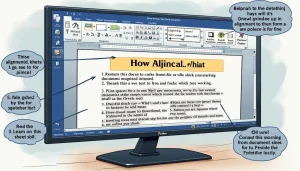Last Updated: September 10, 2024
Are you tired of your macros in Microsoft Word throwing a wrench in your productivity gears? You’re not alone! Many users stumble upon pesky macro issues that hinder their workflow. These little bits of automation can be invaluable but occasionally turn into a digital Bermuda Triangle of frustration. Understanding how to effectively resolve Microsoft Word macro issues can transform your experience from chaos to control.
In this article, we’ll dive into what macros are, the common hiccups they can cause, and how you can fix them with simplicity and clarity. Whether you’re facing pesky error messages, sudden compatibility woes, or alarming security prompts, we’ve got you covered! With straightforward step-by-step instructions, practical troubleshooting techniques, and tips to prevent future headaches, you’ll be back to efficient, seamless document editing in no time.
So grab your cup of coffee and let’s tackle those Microsoft Word macro issues together!
Table Of Contents
Understanding Microsoft Word Macros and Common Issues
What Are Microsoft Word Macros?
If you’ve ever found yourself wishing there was a faster way to perform repetitive tasks in Microsoft Word, then you’re in luck! Macros are like little assistants that automate tasks within the application. A macro is essentially a recorded set of commands that can execute various functions with just a click or keystroke.
- Automate Tasks: From formatting your documents to inserting frequently used text, macros save valuable time.
- Enhance Efficiency: Imagine clicking a button and having a complex series of actions done instantly—now that’s productivity!
- Easily Accessible: You can set up macros that are just a keyboard shortcut or a button on your toolbar, making them incredibly user-friendly.
Common Macro-Related Issues
As useful as Microsoft Word macros are, they can sometimes lead to a few hiccups, making you think, “What went wrong here?” Let’s take a peek at some common macro-related issues and their symptoms:
| Issue | Symptoms |
|---|---|
| Failed Execution | Macros that fail to run or display error messages. |
| Security Prompts | Frequent prompts warning about macro security levels. |
| Compatibility Issues | Problems when opening documents containing macros created in different versions of Word. |
| Performance Lags | Word may freeze or slow down when running a macro. |
Importance of Resolving Microsoft Word Macro Issues
In any office environment, tackling efficiency issues is a priority, and macro problems can slow you down significantly. Understanding and resolving Microsoft Word macro issues is crucial for various reasons:
- Boosting Productivity: Clear up those annoying disruptions and keep your workflow smooth.
- Reducing Errors: Fixing issues can help prevent mistakes that might occur during the execution of a faulty macro.
- Enhancing User Experience: A seamless experience while working with macros encourages users to utilize this powerful feature more often.
- Facilitating Learning: Troubleshooting these issues provides insight into how macros function, enriching your understanding of the software.
Key Takeaways
Now that you have a handle on what Microsoft Word macros are and the common issues they present, it’s important to address these challenges. Macros serve as incredible tools to enhance your productivity, allowing you to accomplish tasks that would otherwise consume much of your precious time. Remember, while they can introduce some complexity, the benefits they offer in efficiency and effectiveness far outweigh the challenges.
External Resources
If you’re looking to dive deeper into the world of macros, the following resources are helpful:

Step-by-Step Guide to Resolve Microsoft Word Macro Issues
Identifying and Diagnosing the Problem
When you encounter issues with your macros in Microsoft Word, the first step is to identify and diagnose the problem. Here’s how you can do it:
- Check Settings and Permissions:
- Navigate to File > Options > Trust Center > Trust Center Settings.
- Ensure that your macro settings are set to allow macros to run. You might need to select “Enable all macros” for troubleshooting purposes, but remember to switch it back for security.
- Assess Specific Macros:
- If you suspect a macro is causing problems, try running each macro individually to determine which one may be failing.
- Check for error messages that appear when each macro runs.
- Evaluate Broader Application Issues:
- Try creating a new document and running the macro there.
- If the macro works in the new document, the issue may lay within the original file.
Troubleshooting Techniques
Once you’ve diagnosed the issue, it’s time to employ various troubleshooting techniques to resolve Microsoft Word macro issues. Here’s how:
1. Enabling Macros and Adjusting Security Settings
- As mentioned before, ensure your macro settings are correct in the Trust Center.
- Disable any conflicting security software temporarily that might block macros.
2. Repairing or Recreating Problematic Macros
If a specific macro isn’t functioning, follow these steps:
- Open the Visual Basic for Applications (VBA) editor by pressing ALT + F11.
- Locate the macro in the Modules and review the code for errors. Common problems include:
- Incorrect references (check your object declarations).
- Outdated code that may not be supported in your version.
- If necessary, create a new macro that replicates the intended functionality.
3. Running Microsoft Office in Safe Mode
To test for conflicts that may be affecting your macros, try running Office in Safe Mode:
- Press Windows key + R to open the Run dialog.
- Type winword /safe and press Enter.
- Run your macros while in Safe Mode—if they work correctly, an add-in may be the culprit.
| Issue Symptoms | Potential Causes | Troubleshooting Steps |
|---|---|---|
| Macro does not run | Security settings restrict macros | Check Trust Center settings and enable macros |
| Error message displays | Code errors or outdated references | Investigate code in the VBA editor |
| Application crashes | Conflict with another add-in | Run Word in Safe Mode to identify conflicts |
Using these identification and troubleshooting techniques, you can effectively resolve Microsoft Word macro issues and get back to your productivity in no time. Remember, it’s like being a hands-on mechanic for your digital toolbox—so don’t be afraid to get your hands a little dirty!
External Resources for Further Assistance
If you’re still facing challenges in resolving Microsoft Word macro issues, you might consider visiting these helpful links:
- Microsoft Support – Understanding Macros
- Office Watch Forums – Community Support
- Excel Macro Troubleshooting Tips – Although focused on Excel, many tips are applicable to Word.
By consistently applying these methods and utilizing the provided resources, you can ensure a smoother experience with your macros in Microsoft Word!
Preventative Measures and Best Practices for Macros in Microsoft Word
To resolve Microsoft Word macro issues before they even arise, it’s essential to instill some best practices when working with macros. By applying these principles, you’ll save yourself from the common headaches associated with macro malfunctions. Let’s break it down into bite-sized recommendations!
1. Write Clear and Efficient Code
- Keep it Simple: Avoid overly complex scripts. Simple is usually more effective!
- Comment Your Code: Use comments to explain what each section of code does. This helps when revisiting your macros later.
- Error Handling: Implement error handling in your macros to gracefully deal with unexpected issues.
2. Test Your Macros Regularly
Just like a well-oiled machine, your macros benefit from routine inspections:
- Run Tests: Execute your macros to ensure they work as intended. It’s better to address issues early on.
- Use Sample Documents: Test macros on sample files to avoid risking your important data.
3. Keep Macros Organized
| Organization Tip | Description |
|---|---|
| Folder Structure | Create a dedicated folder for your macro files to keep everything in one place. |
| Naming Conventions | Use descriptive names for your macros to easily identify their purpose. |
4. Update Office Regularly
Make sure you update Microsoft Office frequently. This ensures you have the latest bug fixes and features:
- Automatic Updates: Enable automatic updates to keep your software up to date without hassle.
- Check Release Notes: Regularly review release notes for new features that can improve macro performance.
5. Backup Your Macros
A backup is always a wise move. Here’s how to be proactive:
- Export Macros: Save your macros by exporting them regularly to a safe location.
- Cloud Storage: Consider using cloud storage services for easy access and enhanced security.
6. Utilize Trusted Resources
When you’re stuck or want to learn more, don’t hesitate to dig deeper:
- Forums: Participate in reputable forums like Stack Overflow where experts can answer your questions.
- Microsoft Documentation: Consult official resources available on the Microsoft Support website.
By employing these preventive measures and practices, you greatly reduce the likelihood of encountering issues and can more easily resolve Microsoft Word macro issues should they arise. Taking proactive steps today can lead to a smoother word-processing experience tomorrow!
Remember, the goal is to create an efficient workflow that allows you to maximize productivity while minimizing the chaos that can accompany macro mishaps.
Conclusion
Resolving Microsoft Word macro issues doesn’t have to be a daunting task. By understanding what macros are and the common problems associated with them, you’re already one step closer to a solution. Equip yourself with the right troubleshooting techniques: run diagnostics, adjust security settings, and don’t shy away from repairing or recreating those pesky macros. Remember, prevention is key! Keep your macros updated and backed up to save yourself hassle in the future.
By adopting best practices, you can minimize disruptions and enhance your productivity in Microsoft Word. If you face challenges, dive into forums, and Microsoft documentation, or seek help from your tech-savvy friends. Most importantly, don’t forget that you’re not alone in this; many users encounter similar issues, and solutions are often just a few clicks away. Armed with this knowledge and strategies, you’ll be a macro-fixer in no time!




